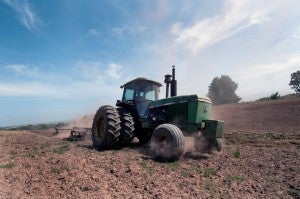 As spring planting season gets underway, many farmers are starting to wonder how much nitrogen they should apply to their crops this year to maximize yields.
As spring planting season gets underway, many farmers are starting to wonder how much nitrogen they should apply to their crops this year to maximize yields.
The traditional approach is to apply a bit of extra fertilizer as an insurance policy to protect yields in case some of it washes away. The problem is, this is costly – nitrogen fertilizer accounts for at least half of farmers’ input costs, even though on average, 50 percent of the nitrogen applied is lost – and harmful to air and water quality.
What we need is to get to a sweet spot of fertilizer application – meaning the right amount that both protects natural resources and maximizes yields.
I asked Thomas Morris, professor of soil fertility at the University of Connecticut, about ways that research, precision agriculture tools, and data analysis can help farmers determine the right amount of fertilizer to apply to their crops.
Is the old adage about “a pound of nitrogen per bushel” accurate?
Many farmers who have been paying attention to the latest research about nitrogen management know that nitrogen rate cannot be boiled down to a rule of thumb.
Sometimes, a pound per bushel may be right – but in general using rules of thumb for a complex decision like how much nitrogen to apply to individual corn fields only results in over and under application of nutrients, which is not good for the farmer or for the environment.
How can a farmer determine the right rate of nitrogen application?
The best way to decide on the rate of nitrogen for a corn field is to start with a baseline recommendation from a nearby land grant university then participate in a farmer network to conduct some easy on-farm research to gain knowledge about how to modify the recommendation for an individual field.
What is a farmer network?
Farmer networks are groups of producers working with an advisor to conduct on-farm trials – in this case, for nitrogen rates. The Iowa Soybean Association is the leader in this innovative model for real-world testing of nitrogen application, and over the past decade EDF, among others, established additional farmer networks across the country. The networks combine key precision ag tools and strip trials to fine tune the best rates of nitrogen application for each farm.
Surveys of farmers participating in the networks show the longer they participate in farmer networks the more comfortable they are with reducing N rates. This leads to greater efficiency on hundreds of thousands of acres.
Good choices for networks of farmers to join are the Iowa Soybean Association’s On-Farm Network, the Indiana On-Farm Network, the Maumee Farmer Network located in Northwest Ohio and Northeast Indiana, the Mackinaw Farmer Network near Bloomington Illinois, Agriculture Inputs Management Network (NC State), the On-Farm Research Partnership (Cornell), or the Kansas Ag Research & Technology Association in Kansas.
What did the farm trials reveal about nitrogen?
Thousands of strip trial research plots completed by the farmer networks noted above, and nitrogen response trials compiled to populate the database for the regional (Corn Belt) approach to nitrogen rate guidelines (Maximum Return to N or MRTN), definitively show that there is no rule of thumb for the rate of nitrogen to apply to an individual corn field.
The MRTN database provides a process to calculate the economic return from nitrogen application with different nitrogen and corn prices, and it is the best place to obtain a baseline recommendation for farmers in the seven states (IA, IL, IN, OH, MI, WI, MN) that use this approach.
Result of trials from these sources have measured economic optimum nitrogen rates from zero pounds of nitrogen per acre on a small number of fields, to greater than 250 pounds of nitrogen on a similarly small number of fields. Most fields needed between 100 and 200 pounds of N per acre to attain the economic optimum nitrogen rate.
The important take away here is that farmers know their farms better than anyone else – and it will take some trial and error to get to that sweet spot. But the risk is worth the reward of saving farmers money and protecting water quality for communities.









